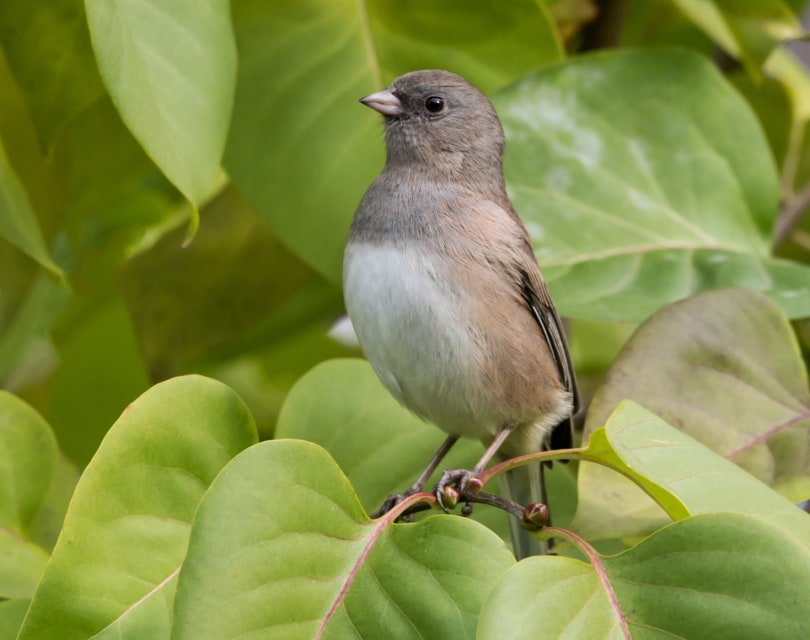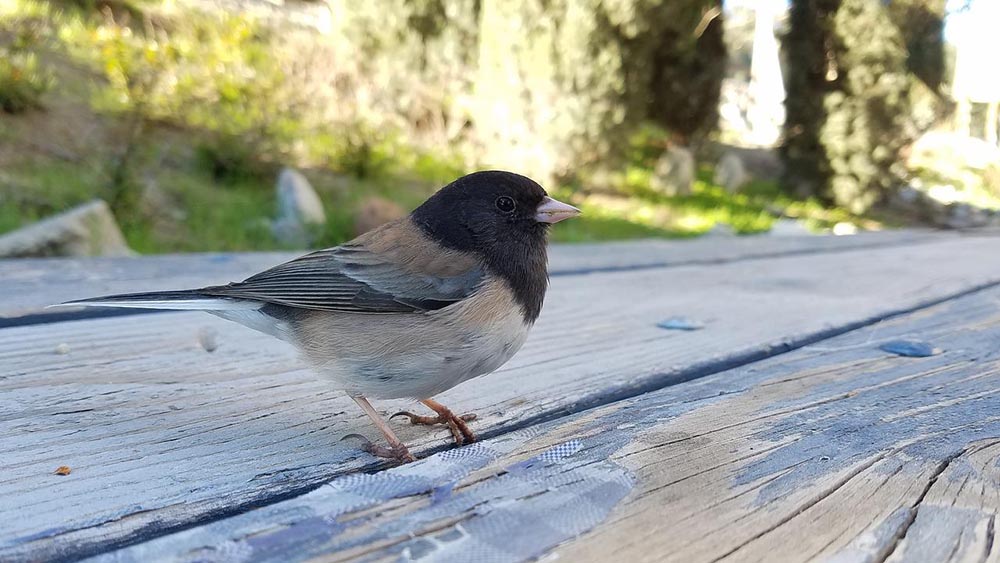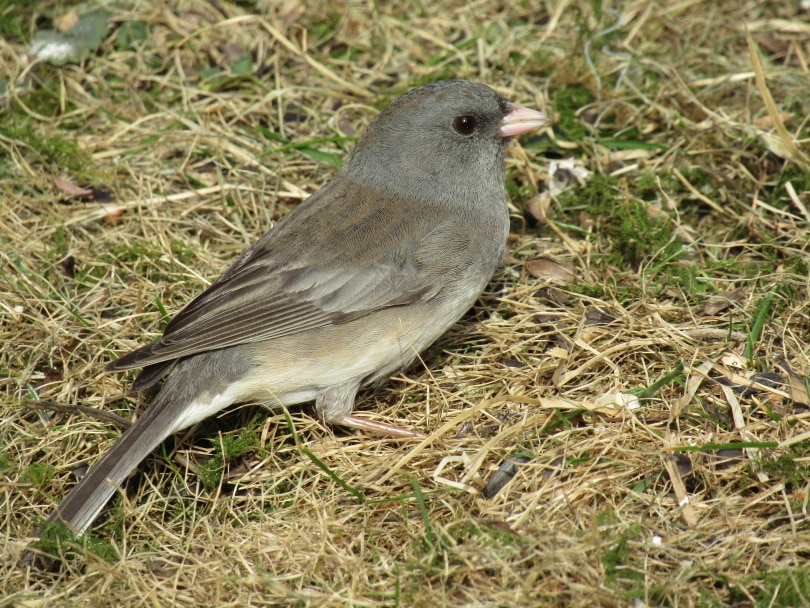Dark-eyed Junco: Field Guide, Pictures, Habitat & Info
Last Updated on

There are few birds more prolific in North America than the Dark-eyed Junco. Most of the year, you’ll find them in abundance in America, Canada’s western mountains, and the Northeast US. However, it’s during winter that these tiny, flashy sparrows truly make an entrance. If you’ve ever heard the term “snowbird’ used for someone who travels south to escape winter’s foul weather, the Dark-eyed Junco is where they got the nickname. During warmer months, as most snowbirds do, they travel further north and to higher elevations.

Quick Facts about the Dark-eyed Junco
| Habitat | Everywhere in North America, including Alaska. |
| Diet | Mostly seeds (about 75%) and insects (25%). |
| Behavior | Foragers that stick close to the ground. Males are dominant and perform mating rituals. |
| Nesting | Typically on the ground under heavy cover from grass, roots, logs, and rocks. Females build the nest. |
| Conservation | Listed as a bird species of “least concern.” |
| Scientific name | Junco hyemalis |
| Lifespan: | 3 to 11 years |
Dark-eyed Junco General Description
As a sparrow, the Dark-eyed Junco comes in various color patterns, including shades of tan, white, slate gray, and brown. What they do have in common, however, is their pinkish bill and their outer tail feathers, which are always white. Their belly feathers are almost always white, while some may have a brownish tinge only on their backs. They are found in flocks and are mostly foragers that stick close to the ground to find seeds and insects. Dark-eyed Juncos are migratory birds that fly north to south during the winter and summer seasons.

Dark-eyed Junco Range, Habitat, Behavior, Diet & Nesting
Range
You can find the Dark-eyed Junco practically everywhere in North America, including the United States, Canada, and Central America. They go as far north as Alaska and as far south as Central America, including Mexico, Guatemala, and Honduras.Habitat
The forest is where you’ll find the Dark-eyed Junco most often, especially in coniferous forests filled with pines, spruces, and firs. They’re fond of deciduous trees, especially oak, hickory, cottonwood, and hickory. During mating season, they utilize a much larger habitat. That’s when you’ll find them in gardens, parks, fields, and even on the roadside.

Behavior
While they might occasionally come to the feeding tray of a bird feeder, Dark-eyed Juncos prefer the seed-littered ground beneath. They will often scratch at the ground to find seeds and insects. As winter approaches, several Juncos form massive flocks, with a specific and hierarchal pecking order based on which birds showed up first. Male Dark-eyed Juncos are highly territorial and put on quite a show of fanning their wings and hopping around to attract a mate.
Diet
The Dark-eyed Junco’s diet consists mostly of seeds (about 75%) and insects (25%). The seeds come from weeds and grasses like chickweed, buckwheat, and sorrel. The insects range from beetles and grasshoppers to caterpillars, spiders, ants, and true bugs like aphids, cicadas, and stink bugs.
Nesting
Surprisingly, the tiny birds nest on the ground, typically under heavy cover from grass, roots, logs, and rocks. Females build the nest, which, on occasion, can be on a perch like a building ledge. However, it’s unusual for the perch to be more than 10 feet above the ground. The nests can be constructed from a wide variety of materials, but most are made with a stable foundation of twigs and then lined with softer materials like hair, grass, and moss. Others can be a simple lining of grass or pine needles only.

How To Find the Dark-eyed Junco: Birdwatching Tips
As one of the most abundant bird species in North America, it’s not difficult to spot a Dark-eyed Junco. You’ll find them in your local forest or park, mainly on the ground in smaller flocks. If you have a bird feeder, look for them underneath as they prefer to forage rather than fly up to their food.
What To Listen For
Dark-eyed Juncos usually sing in short bursts of seven to eight trills in around 2 to 3 seconds. The calls vary in tempo and pitch, and the birds alsomake clicking noises that sound like someone clicking a nail on a blackboard.
What To Look For
Most Dark-eyed Juncos are slate-gray or dark tan (in Oregon) on top with pink bills, white tail feathers, and white underbellies. As a member of the sparrow family, they are small birds. As we mentioned, you’ll find them in flocks, usually foraging together on the ground.
When To Look
You’ll find Dark-eyed Juncos year-round in many parts of North America, although in summer, they migrate to higher elevations. However, the best time to spot them is the end of autumn, as winter sets in.

Attracting Dark-eyed Juncos to Your Backyard: Tips & Tricks
It’s easy to attract Dark-eyed Juncos to your backyard and enjoy their small-bird antics. All you need to do is supply their basic needs, which include food, of course, as well as water, shelter, and sites for nesting.
Food
As a granivorous bird species (i.e., birds that like seeds and grains), Dark-eyed Juncos are big fans of millet, cracked corn, and hulled sunflower seeds. Sprinkling them on the ground is best since they stick to the ground when searching for food. In winter, a covered bird feeder works best. (See below.)
Bird Feeders
Like most birds, Dark-eyed Juncos will choose a bird feeder in winter because it’s easier to find the food they need to survive. The best choice is one with a wide roof to keep snow off the bird buffet. During other seasons, it’s best to have a bird feeder under a covered spot like beneath a picnic table. (The lower to the ground, the better.)
Grass and Flowers
To attract the Junco, you can plant ragweed, chickweed, coneflowers, and marigolds. Also, during fall, leave your leaf piles intact. The inevitable bugs and insects are an excellent food source for Dark-eyed Juncos.

Water Features like Bird Baths. Ponds, and Waterfalls
Like most birds, Dark-eyed Juncos prefer to drink and bathe in birdbaths. In winter, waterfalls that keep water from freezing are recommended. Whatever you choose, make sure it’s close to the ground.
Nesting Materials
Juncos use pine needles and moss as nesting materials, as well as animal fur from dogs, small twigs, and several types of grass. One thing to remember is that Dark-eyed Juncos seldom reuse their nests. For that reason, you can remove them after their babies have flown off. Removing old nests often encourages them to make more nests and breed multiple times.
Window Protection
Dark-eyed Juncos are very vulnerable to window collisions. For that reason, if you’re keen on attracting them to your backyard, putting something on your windows like tape strips or mosquito screens is a good idea.
Dark-eyed Junco Conservation: Is this Bird Threatened?
As one of the most abundant bird species in North America, the Dark-eyed Junco is not threatened and is listed as a bird species of “least concern” with a stable population. However, due to climate change, their habitat is threatened.
Recent estimates suggest a population of nearly 630 million adult Dark-eyed Juncos in North America. However, their population is decreasing, mostly due to climate change we mentioned and habitat loss.


Conclusion
The Dark-eyed Junco is a common bird that ranges from Northern Mexico to Alaska. They rely on seeds and insects to survive, are foragers that stick close to the ground, and are migratory birds. You will find them in local parks, forests and anywhere grasses and seeds are readily available.
While they are not an endangered species, the Dark-eyed Junco’s habitat and population are shrinking due to climate change. However, it’s easy to attract Dark-eyed Juncos to your backyard with low-hanging bird feeders, bird baths, and nesting materials like grasses, small twigs, and mosses.
Featured Image Credit: FotoRequest, Shutterstock
Table of Contents
- Quick Facts about the Dark-eyed Junco
- Dark-eyed Junco General Description
- Dark-eyed Junco Range, Habitat, Behavior, Diet & Nesting
- How To Find the Dark-eyed Junco: Birdwatching Tips
- Attracting Dark-eyed Juncos to Your Backyard: Tips & Tricks
- Dark-eyed Junco Conservation: Is this Bird Threatened?
- Conclusion
About the Author Greg Iacono
Greg Iacono is a self-taught writer and former chiropractor who, ironically, retired early due to back problems. He now spends his time writing scintillating content on a wide variety of subjects. Greg is also a well-known video script writer known for his ability to take a complex subject and make it accessible for the layperson.
Related Articles:
10 Types of Hummingbirds in Arkansas (With Pictures)
8 Types of Hummingbirds in Nebraska (With Pictures)
5 Types of Hummingbirds in Idaho (With Pictures)
3 Types of Hummingbirds in Mississippi (With Pictures)
8 Types of Hummingbirds in Kansas (With Pictures)
5 Types of Hummingbirds in West Virginia (With Pictures)
5 Types of Hummingbirds in Ohio (With Pictures)
Where Do Nuthatches Nest? Nuthatch Nesting Habits Explained
